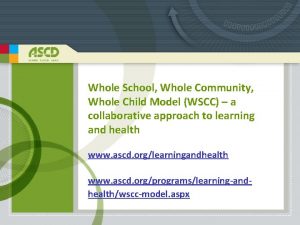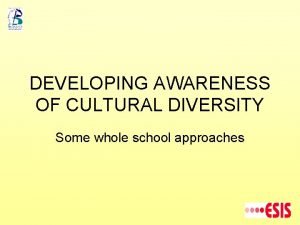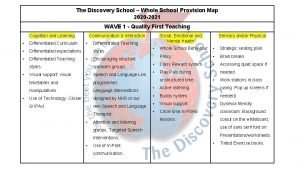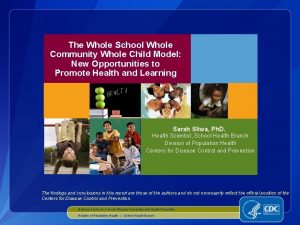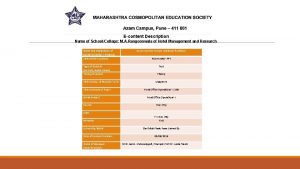Section 1 Whole School College Implementation Whole SchoolCollege














- Slides: 14

Section 1: Whole School/ College Implementation

Whole School/College Approach to Mental Health and Emotional Wellbeing 1. What does your setting do well? 2. What’s been highlighted during covid? 3. Where are the gaps? Czone Whole School Approach guidance (Source Public Health England Children and Young Peoples Mental Health Coalition, 2015)


5 key principles of recovery from community trauma A sense of safety A sense of hope A sense of calming 5 key principles of recovery from community trauma A sense of connectedness A sense of self and community efficacy Hobfall et al, 2007

Establishing safety • Clear, workable social distancing measures • Predictable, familiar structures and routines: a whole school approach to rules, expectations and consequences • Meeting and greeting • Removing or distracting a child from a situation they are not managing • Being open and engaged with a child: What is hard/not hard for you? How did this happen? What was that like? How did this affect you? • Thinking out loud, staff being open and authentic about their own worries using ‘I statements’ – in age appropriate way • Safe, calm zones/resources/routines in classrooms

Creating a calm environment Play – light, warm interactions with cyp foster safe connection Acceptance - accepting and acknowledging feelings underneath a child’s behaviour helps them to trust you not to shame/belittle/criticize them and to open up Curiosity - a pro-active, voiced interest in how the child is experiencing an emotionally charged event (past or present). ‘Will you help me understand…? ’ Empathy - A felt sense of ‘the other’, actively experienced by the adult and communicated in words to the child: thinking out loud together, e. g. ‘I wonder’, ‘I imagine’, ‘I notice’, etc. PACE (Dan Hughes, 2016)

Self and community efficacy • Involve the whole school in planning the way forward • Acknowledge the challenges that some have experienced • Consult and co-design with pupils to help address gaps in learning • Reassure pupils by re-establishing baselines • Set achievable, realistic goals with appropriate challenge • Share plans as you develop them so that pupils have a sense of control and feel that the work will be manageable • Continue to provide opportunities for open discussion to ensure that worries are voiced and addressed

Connectedness - relationships • Recognise your importance as a trusted adult • Maintain regular, light touch contact • Consider how you will keep connected to staff/cyp who are not returning to school yet • Offer a key point of contact for questions and concerns – generic email in-box / FAQ updates on website / news • Some parents and carers may continue to need an enhanced level of contact – designate appropriate staff if possible

Group discussion 0 to 10 Cyp Staff Feeling safe Feeling calm Self & community efficacy Relationships Options and opportunities 1. What’s working well? 2. What needs to change? 3. What will be the challenges? 4. Who can help you overcome these? 5. What would success look like? Parents/carers

What are we doing in our setting to support the 5 principles of community recovery? Creating a sense of safety Putting emotional wellbeing first for everyone Affirming safety (physical and emotional) and routines Creating a sense of calm Accepting and talking about the range of experiences, feelings and responses Self & community Relationships efficacy Affirming Ensuring strengths/values relationships are positive and helping centre-stage individuals to self-manage facilitating community endeavour Looking ahead Acknowledging loss, change and bereavement as an essential stage in considering future options and aspirations

The Challenge For Education Organisations How can this learning be incorporated into each school/college vision and ways of working? Example: Build a Mental Health and Wellbeing team with Senior Leadership Team, Key Staff, Pupil/Student Voice, Parent/Carer Voice (remember all Staff, SENCOs, pastoral and senior mental health leads, heads of year, Teaching Assistants, Sports Coaches, lunchtime assistants, external support e. g. MHSTs, counsellors, educational psychologists, school nurses).

How Do Pandemics Affect Learning In Schools/Colleges? Observed Negatives: • Fear, stress, death, other losses, low mood, confusion and anger • Changes in children’s behaviour, attention/concentration • Further inequalities and disparities Causing: • Impact on relationships, decrease the flexibility of thinking and coping • Diminishing sense of agency and therefore level of resilience • Closing doors to learning Observed Positives: • Compassion • Community mindedness • Concern Creating: • Opportunities to open doors to new learning • New relationships • Increases in flexible thinking and coping • More agency (a sense that you can make changes happen) (Co Space Study 2020) (Huremovic 2019) (Creswell et al 2020) (ONS 2020)

• Normalising worry about returning to education - emotions are a part of normal, everyday life • Understanding the importance of a whole setting approach which promotes kindness, compassion, flexibility and takes a positive psychology approach • Building on existing strengths and skills of children, young people, parents/carers and education provision staff • Differentiated support: ‘all, most, some’

Hope Clouds activity • Using your cloud template, think about your dreams and hopes for the next school year and write them down. They can be big or small, short-term or longterm. • If you would like to share, tell the group about your dreams and hopes and why you chose them. • Write one thing on your hope cloud that you will do to get closer to your dream and one person that you could ask for help.
 Cdc whole school whole community whole child
Cdc whole school whole community whole child Early college high school at midland college
Early college high school at midland college Massed practice
Massed practice Wake tech admissions
Wake tech admissions Whole school approach to cultural diversity
Whole school approach to cultural diversity Whole school provision map
Whole school provision map Case study ethan and college expenses
Case study ethan and college expenses T-stem early college high school
T-stem early college high school Nurul alam school and college
Nurul alam school and college El valle verde
El valle verde Queens high school for the sciences
Queens high school for the sciences Aspire iechs
Aspire iechs Berry college school colors
Berry college school colors Flora's first day at school question answer
Flora's first day at school question answer Mission early college high school logo
Mission early college high school logo
